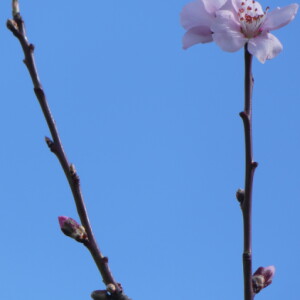Promising
Today I had a meeting with a medical professional and another with a car mechanic. One of them told me I have a "failure of [my] body control module", the other told me to keep taking the tablets. You can decide which is which
The scruffy-looking plant in the foreground here is oilseed rape (usually abbreviated to OSR, and also called colza, rapeseed or canola), Brassica napus. Most years, it is the source of more than 50% of our honey crop. This field is right beside the apiary - no need to fly, the bees can come overland. My notes from last year say that I saw the first OSR flowers on 28 March "in freezing weather: rain & snow", which echoes what happened today, before this blue sky
To beekeepers, OSR is a blessing and a curse. It is an abundant source of nectar and pollen, unsurpassed by any other agricultural crop here. But, along with the advent of the parasitic Varroa mite, it caused many experienced beekeepers to lose heart and quit the craft in the 1980s and 90s.
Traditionally (pre-1980) it was regarded as very bad form to harvest any honey before September. However, if the honey includes any significant OSR, this approach is doomed. OSR nectar contains higher than normal levels of glucose. This results in a honey that crystallises into 'set' form with astonishing rapidity and, even though the bees keep the colony temperature at 35 degrees, this also happens in the hive, in the wax honeycomb, making it impossible to extract as a harvest
It is necessary, then, to extract OSR honey almost as soon as it is made. But therein lies a danger: the beekeeper must first allow the honey to 'ripen'. Having mixed nectar with enzymes and put it into the comb, the bees then evaporate water from it to increase its concentration - they create air currents through the hive by co-ordinated wing-flapping. If the water content of the honey is more than 18%, there is a risk that it will ferment in the jars - not dangerous, but extremely sticky-messy and, of course, wasteful
If the bees have put wax caps on the honey cells, it is ripe and ready to extract. But the absence of caps is not proof of unripeness - I have seen uncapped honey crystallise in the comb. Late May and early June becomes a nail-biting push-me-pull-you of risk assessment and self doubt. Let's hope we get that far; if it happens, it's a problem of success
The OSR will not flower until it has produced stems 100-150cm hight at least. When the weather warms, it will grow with spectacular speed but, even so, flowering in 14 days is a big ask. The Great Algorithm in Cyberspace sent Mrs M an image this morning: "one year ago today" - our almond tree in full blossom. I checked it this afternoon and found just two flowers. I don't think we are going to have OSR nectar on 28 March (but if we do, I will blip it, I promise)


Comments
Sign in or get an account to comment.


